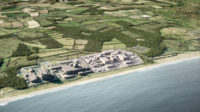
Officials of the European Union are soon to probe the legality of U.K. government guarantees to the private-sector developer of Britain's first nuclear powerplant since the mid-1990s.
While the EU investigates whether the guarantees comply with its state aid rules, the French-led developer of the three-reactor, 3,300-MW Hinkley Point C plant already has cleared its 180-hectare site in west England and spent hundreds of million of dollars on associated infrastructure.
"We are in good shape" in terms of U.K. permitting, says Richard Mayson, U.K. project development director of France's state-owned EDF Group, which will control up to 50% of the plant consortium when contracts are signed.
The EU review is the last external hurdle, he adds.
A deal with the U.K. government last year would guarantee the project owner a minimum price for its power output for 35 years after operations start in 2023. The U.K. also would underwrite the developer's commercial construction loans.
The government and EDF hope the state aid probe is done before the EU commissioners, its executive board, ends its current five-year term later this year. "We are not planning on receiving a negative conclusion," says Michael Fallon, a government energy minister.
With a positive ruling, the EDF team would step up construction, which has been under detailed development for 18 months. Funded by EDF, the joint venture of Bouygues, Paris, and Laing O'Rourke, U.K., now has a planning staff of 50.
For its roughly $3.4-billion contract, the team is relying on 3D and 4D digital modeling to plan site logistics, operations and detailed design, says Martin Westbury, project director.
The 1 million cu meters of concrete to be used will include 250,000 tonnes of rebar and 250,000 cast-in-place items, creating great complexity, he adds. "We will manufacture, precast and prefabricate," he says. "These are critical-path activities."
At peak, the project will employ 3,500, and the JV will have 750 on staff. He says it will search globally for up to 70 "top notch" welders and create apprenticeships to secure 800 "steelfixers," as U.K. rebar workers are called.
Steelfixers, scaffolders, project managers and concrete crews are among classifications the emerging U.K. nuclear program could find in short supply, says Charles Bray, a manager at the industry-led National Skills Academy, Nuclear.
With two more projects set to follow Hinkley Point C, work may overlap, increasing pressure on resources, adds Claude Bernard, technical director of NuGeneration Ltd., the London team developing a 3,400-MW plant in which Toshiba Corp. now has a 60% stake. The third prospective developer, aiming for 5,400 MW at separate sites, is Horizon Nuclear Power, owned by Hitachi Ltd.
With nearly half the Hinkley work set to go to foreign firms, the future for Chinese contractors is unclear, says Mayson.
The job will tap valuable nuclear expertise from EDF potential partners China General Nuclear Corp. and China National Nuclear Corp. But China's planned 30% to 40% stake will not guarantee its contractors work on the site, he adds.
“They want the opportunity to be part of the bidding process and we’ve made it absolutely clear that [it will be] a proper bidding process with each company being treated on its merits, Mayson says. "They’re not getting guaranteed contracts."







